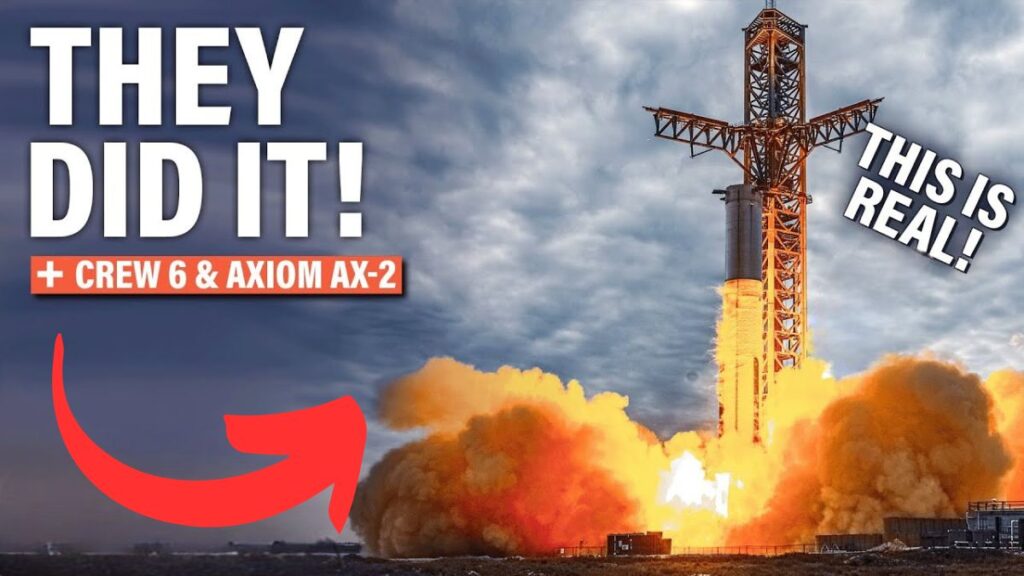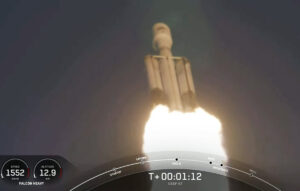
More thrust than a Saturn V!
SpaceX’s Starship Super Heavy Booster made history!
31 Raptor engines lit at the same time!
And more thrust than the Saturn V Moon rocket!
I’m explaining the whole craziness, and I’ll take a fascinating look into the future with you!
Stay tuned, and let’s dive right in!
Starship Updates We’re weeks, maybe even days away from the big moment the spaceflight enthusiast community has been waiting for for some time now.
SpaceX is getting ready to revolutionize Spaceflight again.
And their invention to make it possible is this.
What you’re looking at here is a static fire test of SpaceX’s Super Heavy Starship booster.
It took place one week ago, on February 9th, in Boca Chica, Texas.
The location where SpaceX is running a large test facility called Starbase.
The Starship’s goal is full and rapid reusability.
Broken down, this means nothing less than a drastic price reduction.
Where today, a Falcon 9 launch costs around 50 million dollars and can get you around 17.4 tons of usable cargo to low Earth orbit, a Starship will change these numbers quite significantly.
Up to 150 tons of payload, and Musk once stated that a launch could eventually come down to 1 million dollars.
“One million dollars.
” Granted, 1 million is a very optimistic sounding number.
The reason why Elon stated such a low number is in the second attribute of the set goal.
Fully and RAPIDLY reusable.
If it all plays out the way SpaceX wants it to, launches will happen multiple times per day, and each Starship and Super Heavy booster will be capable of hundreds of launches each day.
This would result in a price of below ten dollars per kilogram to low Earth orbit.
A number that is so low that even the most notable experts in the spaceflight industry disagree.
So, how is SpaceX trying to turn something the Spaceflight industry deems impossible into reality?
After all, even if their engineering department is cutting-edge, they can’t perform magic, right?
There aren’t any miracles involved, and last week’s static fire demonstrated it quite impressively.
For the first time in SpaceX’s Starship development history, a Super Heavy booster, so the first stage of the Starship, lit almost all of its engines.
The official numbers announced by SpaceX were 31 engines at 7.9 million pounds of thrust, which equals roughly 3600 tons.
This is less than half of what the booster is capable of but even at this low setting, it is more thrust than what the Saturn V Moon rockets produced at lift-off.
Another record on SpaceX’s growing list, and we’re getting into the realm of the most giant rockets ever built.
Musk explained on Twitter, stating that the team turned off one engine just before starting, and one Raptor stopped itself during the static fire.
It is very likely that the engine turned off by the team before ignition just had the wrong numbers on one or more sensors.
It indicated to the team that taking the safe approach would be the better way to go.
The second engine shutting down during the static fire is referenced by Musk as “stopped itself.
” This likely translates to the engine detecting out-of-range parameters during the static fire, resulting in the engine controller properly turning it off.
Even though there were problems with two engines, both problems did not cause any further issues and could be dealt with in an orderly way.
Musk added that this would have still been enough to reach orbit.
Of course, if all engines were running at full throttle.
Traditionally, when these important tests are happening, Elon Musk is very active on Twitter, and we appreciate it very much!
He even gave the throttle numbers.
Only roughly 50%.
And he gave another estimate on the first launch date.
The launch attempt next month will be at roughly 90%.
So, this is what roughly 50% throttle with two engines short looks like on the most powerful and most giant rocket ever built.
And we’re here to watch it unfold.
So, this just happened.
The Russian N1 Moon rocket gave away its decades-long record of most engines fired simultaneously with 30, and Saturn V, the pinnacle of the Apollo program and most iconic rocket in history, was passed in thrust output.
This is real.
Pinch me.
Now, let’s take a look at how the ground support equipment, so everything else but the rocket itself held up.
Was there damage, or did the 31 Raptor engines leave the launch mount and the tower intact?
And who better to take in on this than Mauricio from RGV Aerial Photography?
He did a flyover again, and his pictures tell a positive story!
And the first thing everyone asked me on Twitter after the static fire was about concrete.
The reason behind it is simple.
SpaceX decided against flame diverters and a proper deluge system for the Starship launch mount.
This has caused problems all throughout the test campaign so far.
Concrete tends to shatter when blasted with Raptor engines.
They’re already working on a solution, but more on that later.
For now, this is what it looks like.
Blast residue everywhere, but the concrete below the OLM seems largely intact.
Up close, there might be a different story, though.
Looking at Chief’s footage up close shows it all.
Just before the ignition, the Firex system kicks in.
It’s the water being sprayed under the launch table.
This is supposed to mitigate the risk of a combustible mixture of propellant gasses below the engines.
It does affect the blast, but its main goal is to prevent explosions.
Then the ignition happens, and in the developing plume, we can see the amount of debris ejected from the orbital launch mount during the static fire, and yes, there it is.
Don’t concentrate on the slower-moving large parts.
The little pieces of gray rocks are what’s interesting and they’re very likely concrete from under the launch mount being blasted off by the engines.
When heated up quickly, even especially heat-resistant concrete like Fondac, which SpaceX uses under the OLM, tends to crack and almost explode from sheer energy overload.
This is precisely why we see flame diverters, trenches, and deluge systems under virtually every other large rocket launch pad in the world.
Before the ignition, the OLM is covered in gray protection paint.
This is done to prevent it from rusting in the salty Boca Chica sea breeze.
Everything is clean and nice looking.
After the ignition, we see the typical blast marks.
You can even see where the fire went and where it couldn’t reach.
Those are the areas SpaceX is focusing on, and they’re not done with their launch preparations.
Again, more on that later.
SpaceX also provided a live stream of the static fire.
This camera is located on top of Starhopper, SpaceX’s first Raptor engine test vehicle, which is still on site and today used for weather data, security cameras, and in this case, for a ground camera viewing the test activity.
From this view, we can even see where the flames reached, and fascinatingly enough, they even blasted the first few tanks of the orbital tank farm.
Again, this test was done at around 50% thrust.
The proposed 90% thrust from Elon Musk’s tweet would look very different with even more flames shooting all around the launch pad.
“This leads us to the directly to the SpaceX’s future plans” This leads us directly to SpaceX’s future plans for the launch pad and some of it even before the orbital launch attempt in March, but before we get to that, hammer the like button for me, share the article if you liked it, and remember to subscribe to the channel while you’re at it!
This helps us hugely to continue our work!
Thank you!
Take a look at this with me for a second.
Starbase sometimes feels like a where’s waldo picture.
Since development at SpaceX’s Starship test site is so quick, there is a constant supply of smaller and larger parts coming in with semi-trucks.
Those are stashed all over the site and sometimes, there are hidden treasures among them.
Like these.
Situated right next to the ramp leading up to the suborbital test stands, there’s a group of new parts.
Those fit the height of the orbital launch table and are very likely going to be installed before the orbital launch attempt.
Ryan Hansen Space has made some very well-done renders illustrating what I just explained.
And this is what it’ll likely look like.
Attached to the side of the orbital launch table, these massive blast shields will further protect the delicate outer systems of the launch stand.
When done, the OLM will likely look like a fortress with almost every surface covered up and ready to take that 90% throttle blast from hopefully 33 engines.
More shielding is coming!
To turn this into somewhat of a traditional rocket pad, only two things would be missing now.
Flame trenches under the pad, which is almost impossible without building a huge concrete hill as NASA did at Kennedy Space Center.
A very high water table close to the sea just makes it impossible to dig down without it immediately flooding.
And secondly, a deluge system.
And these pictures from Mauricio feel so good.
Just looking at them gives a huge confidence boost.
SpaceX is finally building a Deluge System, as explained in the last episode, and it does look beefy!
The barge from Kennedy Space Center arrived with the parts a few days ago, and progress is fast as always at Starbase.
The system is pretty simple but very effective.
The small high-pressure tanks provide just that.
A high gas pressure.
Likely Nitrogen.
The larger tanks in front store water.
The huge pipe coming out under the water tanks leads to a manifold, which distributes the water likely to rain birds under the pad.
So, SpaceX replaces the traditionally used large water tower with high-pressure gas tanks which push the water to the pad in seconds.
Lastly, the water needs to be collected and filtered to be reused for the next launch.
Same as at Kennedy Space Center and needed as an FAA requirement for the launch license.
Owe from SpaceX 3D creation eccentric has been working with us here at WAI again, and this is part of the deluge system to be installed directly under and surrounding the Starship orbital launch mount.
In the same way as already done at Kennedy Space Center, Pad39A’s Starship launch mount it will be lowered into the ground.
We don’t exactly know how this part will work.
There are two scenarios.
The first scenario would be this.
The ring structure is directly connected to the water outlet of the tanks, spewing water out and directly under the orbital launch mount while the booster is ignited.
It is possible but also unlikely for several reasons.
Spewing out water like this is not very effective.
The blast of the engines is coming from above, and you want the water to mix as best as possible with the engine exhaust.
These deluge systems work in a simple way.
You want to get rid of energy.
Shuttle launches are a perfect example.
Suppression system on, main engine ignition, booster ignition, and release.
While the engines are firing, the water, which is sprayed directly into the exhaust in fine drops, turns from liquid to gaseous.
This takes energy.
Energy which is then stored in the resulting steam and can’t hit the pad anymore.
Simple.
Circling back to scenario number 1, you can see that the water would have a hard time not being pushed flat against the concrete under the pad while battling with the exhaust coming from above.
Not a good mixture.
Secondly, how would you collect the water?
Which brings us to scenario number 2.
In this case, there are rain birds directly under the launch table, spraying the water into the exhaust stream, and the ring acts as a drainage system.
This way, the mixture, so the percentage of the water actually turned into steam, would be significantly increased, and the collection would almost be 100%.
Ready for reuse for the next launch.
We’ll have to wait and see what SpaceX actually does end up building.
Likely after the first launch.
What do you think?
Will SpaceX use it as a circular rainbird or as a drainage system together with rainbirds further up?
As always, let me know in the comments below!
Also, I am super excited to announce that we’re teaming up with Astro Liz to help inspire young minds for STEM with the Astro Liz Young Explorers Fund.
This is something I have been waiting to announce for a while now!
Join in and support young people that couldn’t afford to experience space activities like a day out at the space center, watching a launch, and maybe even most importantly, supporting their local rocketry club.
Be a part of funding young people to find their place in space!
Check the link in the description!
Help inspire the youth for a better future!
Next up, let’s talk Crew 6!
Arguably the most changed crew launch in SpaceX’s history, it will be Crew Dragons’ next flight to a troubled ISS, hopefully on February 26th!
And we’re going to start this one with a hit!
Nope, not Queen.
A micrometeorite.
On December 15th of, 2022, the Soyuz ms-22 spacecraft, which is currently docked with the international space station, developed a point 8-millimeter diameter leak after a micrometeorite hit the external cooling system.
After analyzing thermal calculations and technical documentation, Roscosmos concluded that MS-22 will need to be brought back without a crew.
This left everyone with two problems.
Missing seats for a return vehicle and a mandatory emergency return vehicle for the ISS.
After moving one seat lining from Soyuz Ms-22 to the larger Crew 5 Crew Dragon Endurance, the lifeboat issue was solved, and to continue the presence of both the US and Russia aboard the ISS, a Russian cosmonaut will fly on Crew 6.
NASA’s SpaceX Crew-6 mission is the sixth crew rotation mission with SpaceX to the International space station and the seventh flight of Dragon with humans aboard.
Among the goals of Crew 6 is Artemis.
More precisely, it will conduct research designed to advance future long-duration living off Earth in preparation for a permanent settlement on the Moon and Mars.
Expedition 69, which will start immediately after Crew 6’s arrival at the ISS, carries several experiments directly related to living on the Moon.
They include a microscope that may work on the lunar surface, a study of space station microbes that could help keep astronauts healthy on the Moon, and an experimental high-speed communication system intended to be used on the lunar surface.
February 26th can’t come soon enough!
Next up, we have Axiom announcing its second mission to the ISS!
Once docked, the Axiom Space astronauts plan to spend 10 days aboard the orbiting laboratory implementing a full mission comprised of science, outreach, and commercial activities.
The mission is targeted for launch in the spring of 2023.
It will be the first private space mission to include both private astronauts and astronauts representing foreign governments, as well as the first private mission commanded by a woman.
Axiom is in the process of building Axiom station.
A private space station with two modules already in production.
AX-2 is directly connected to these station-building efforts.
First, Axiom Station will be an extension to the ISS.
Once module number 4 arrives, the station will have everything needed to be independent and separate from the ISS.
While this is still a bit into the future, the announcement of AX-2 is another step forward in the right direction.
AX-2 is slated for launch no earlier than May of this year and will utilize a SpaceX Crew Dragon and a Falcon 9 rocket.
This and SpaceX’s Polaris missions show an increasing need for a low Earth orbit economy, which is steadily growing.
![Moon Jellyfish has [ Hidden Secrets ] You don't know moon jellyfish](https://spaceupper.com/wp-content/uploads/2022/11/1-1-300x169.jpg)










